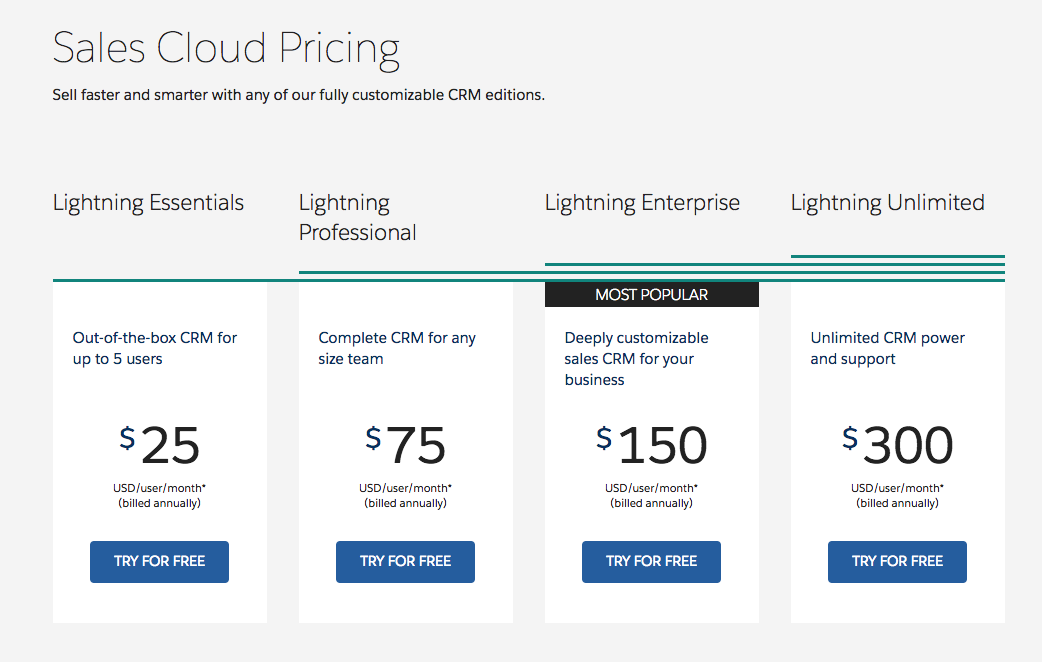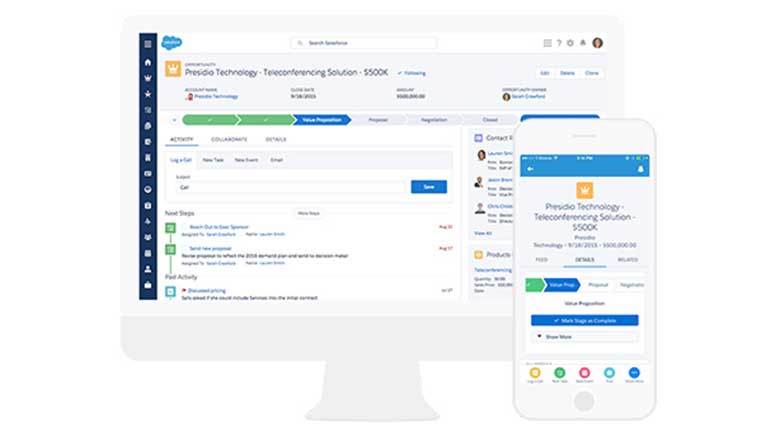DATA MIGRATION
Grow Your Business: Best Practices to Drive Adoption and Success
Growing your Business with Sales Cloud:
Practices to Drive Adoption and Success
“Fail to Plan, Plan to Fail.” It is a common expression and we all know it to be true. No matter the resources at your disposal, without a plan to use them properly you will ultimately fall short of your goals. Now that you’ve decided to implement Sales Cloud, you have the task of introducing it to your teams and teaching them to use it effectively. With proper execution, Sales Cloud will become a powerful tool and major factor in your company's future.
In this session of Dreamforce, Senthil Kumar, Customer Success Director at Salesforce, leads a panel discussion with Bill McKenzie, Global Head of Sales Enablement of Hibu and Michel Mayor, Global CRM CoE of DuPont de Nemours.
Preparation for Implementing Sales Cloud Requires Setting Goals and Transferring Data
Defining objective is the first step of implementing Sales Cloud. The next step is transferring current data into the new CRM system. Consider the following suggestions in order for rollout to go smoothly:
Set small goals at first. Before you can introduce Sales Cloud to your entire company, it is important that you have a direction and specific goals in mind. These goals need to incorporate the visions and objectives of your company. Remember Sales Cloud is a powerful CRM tool designed to make sales and management jobs more efficient and profitable. With that in mind, set a few actionable goals.
McKenzie explains how Hibu implemented Salesforce over a two-year period. Hibu, formerly a yellowpages company had to shift their business model of selling print ads to offering digital advertising. “With the disruption, we had to transform,” says McKenzie. Their staff was largely non-technical and had no CRM background; Salesforce was a big paradigm shift.
To encourage his team to use Sales Cloud instead of printing reports or exporting them to Excel, McKenzie shut off the export feature and distributed leads through Salesforce, giving his 1,500+ team the incentive to use the new system.
Assign representatives from each department. It is essential that the implementation team partner with leaders from each department to ensure successful integration and to help the company reach their overall objectives. This early cooperation will help the company at large embrace the new CRM module and get excited about Sales Cloud. When the entire company is supportive in the rollout, that helps guarantee support in future CRM requirements.
Set goals around KPI metrics. When establishing goals, it is important to focus around KPIs (Key Performance Indicators). Because McKenzie was faced with the unique challenge of helping non-technical, non-digital sales reps adopt cloud-based CRM, Hibu’s KPIs focused on adoption of the CRM program. Logins, recorded activity, and follow-up were the initial KPIs. Sales results were a later KPI metric.
Remember that looking at the rights KPIs will provide a greater success rate. Sales Cloud has a lot of features; it is easy to overwhelm your team if you require managers and leaders to focus on too many metrics. Don’t overwhelm your team with too many metrics. Instead, focus on a few key indicators.
Mayor explains how, over the adoption process, he stepped back to “really understand the business priorities and how you can create value for your customers.” When DuPont started to be customer-focused, CRM adoption success increased.
Data migration is the first step to Sales Cloud. During this period of preparation it is crucial to focus on data migration. No one is going to use Sales Cloud if there is no information there, so data migration needs to be a priority. Having the necessary data will help employees feel more at ease with the new system and reduce the temptation to rely on older programs or systems.
DuPont focused on IT-centric deployments in order to ensure smooth data migration. Mayor explains that the various IT projects were prioritised and then migrated into Salesforce. Hibu’s Sales Cloud implementation gave the company a chance to clean up its data and make sure everything was updated.
Training: The More the Reps Use Salesforce, the More They’ll See the Value
Effective training helps team members adopt Sales Cloud. Before Sales Cloud can be an effective tool, your employees must be comfortable using it. McKenzie recommends first training managers. Next, he advises, train employees in small groups, preferably with multiple instructors. Because Sales Cloud is a hands-on tool, it is highly advisable to provide access to the program while training. Projected presentations will not be as effective.
Start with the managers. Why begin training with managers instead of the sales staff and those team members who will be using Sales Cloud the most? The answer is simple, you want your managers and team leaders to be your most vocal advocates with a firm understanding of the program. Even if they won’t be using Sales Cloud as frequently, they will be in charge of motivating their team to use it. They will also have opportunities to incorporate Sales Cloud into future projects and daily procedures, but only if they have a firm understanding of the program.
Train in small groups. It is understandable that you would want to roll out Sales Cloud to the whole company as soon as possible, and you may be tempted to train in large groups or even virtually; however, this is discouraged. During training you will be dealing with a lot of employees all with varying levels of technical abilities and enthusiasm for Sales Cloud. In order to make sure that everyone adopts and succeeds with Sales Cloud, do in-person trainings with class sizes ranging from 15 to 25. These small classes will allow for more personalised instruction and lead to a much better understanding of Sales Cloud.
The best way to learn Sales Cloud is to use it. The final important element in the training process is exposure to Sales Cloud itself. Allowing access (even limited access) to Sales Cloud during the training will make employees more comfortable with the system and will actually make them more proficient in its use when they are outside of the classroom. Using Sales Cloud in a training setting provides an excellent opportunity to discover and resolve obstacles and confusion while still in the classroom. How much of Sales Cloud you make available is of course your call, but even with limited access you can expect far superior results by letting your employees use Sales Cloud in the classroom.
When teaching teams to use Sales Cloud, consider the end goal: to better serve customers. Mayor shared his vision with his team that the CRM program could ultimately serve the customer better and help reps be more productive. “Sales professionals now benefit from a system that creates value in their day-to-day operations, and is aligned with business priorities and focused on the customer,” says Mayor.
Accompany
At this point you have made your plan, trained your employees, and introduced Sales Cloud to the company. Continue support employees as they continue to learn and use Sales Cloud. Sales Cloud is a robust sales tool and offers features for all parts of business. Ongoing training is essential in order to appreciate Sales Cloud’s full functionality.
It is important to establish a support network for employees as they continue to explore Sales Cloud and to help them overcome any difficulties they may encounter. Create a team that is dedicated to assisting employees with Sales Cloud. This team can be accessible through a number of different channels depend on your need. Some possibilities include: IM chat, designated office hours, and one-on-one training sessions for struggling employees.
This team can also monitor the KPI metrics of adoption so they can see both employees’ and the company’s success with Sales Cloud and offer assistance wherever necessary. If this team is accessible and alert; they will ensure that even outside the classroom your employees will continue to learn and succeed.
While your dedicated team helps you handle the day-to-day operations of Sales Cloud, it is important that you prepare for your company’s future. On a regular basis review the goals you set out in the beginning and their corresponding KPIs. Ask yourself if you are achieving what you set out to accomplish. If yes, great! If no, examine what fields you are struggling in, and look at the corresponding KPIs.
When Hibu became comfortable with Sales Cloud, the number of new customers sold per rep increased 55%, and revenue sold to those new customers increased 53%. Their total revenue per rep increased by 35%.
Mayor explains, “Successful CRM adoption relies on a fragile “give and take” equilibrium established between the employer, the employee and the customer...listen to your customers’ needs, empower your employees to succeed, and you will end up with happy customers and active Salesforce users.”
With simple planning, precise training, and dedicated implementation, Sales Cloud will become a powerful tool to facilitate growth.



